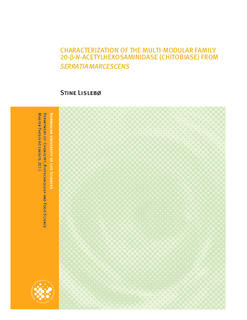Characterization of the multi-modular family 20-β-N-Acetylhexosaminidase (chitobiase) from Serratia Marcescens
Master thesis
Permanent lenke
http://hdl.handle.net/11250/186335Utgivelsesdato
2011-09-06Metadata
Vis full innførselSamlinger
- Master's theses (KBM) [890]
Sammendrag
The aim of this study was to clone and characterize the N-acetylhexosaminidase
(Chitobiase) from the soil bacterium Serratia marcescens. This enzyme is part of the chitinolytic machinery of S. marcescens, a Gram-negative bacterium known for its
efficient degradation of chitin in nature. Research on understanding how this
machinery works will provide knowledge that may be useful in the production of
several chitin-derived compounds, and, thus, for utilization of the abundant resource
that chitin represents. The knowledge of chitin degradation can also be used for better understanding the process of degradation of other carbohydrates, such as cellulose, which also represents a great resource, as it has potential in replacing fossil fuels. After successful cloning, expression and purification of the enzyme, kinetic analyses of its properties were performed with both artificial and natural substrates. The kinetic parameters calculated for the artificial and natural substrate were similar:
KM = 52 +/- 3.545 μM (4-MU-GlcNAc), KM = 55 +/- 9.17 μM (GlcNAc2) and
Kcat =129 +/- 2.517s -1 (4-MU-GlcNAc), Kcat = 135 +/- 5.975 s -1 (GlcNAc2), an
observation that provides insight into the rate-limiting step in the catalytic
mechanism of Chitobiase.
Experiments on degradation of β-chitin did not reveal any synergistic effects
when combining chitinases and Chitobiase. The rate of β-chitin degradation by
Chitobiase increased when incubated together with CBP21 (in presence of reduced
glutathione), a recently discovered oxidohydrolytic enzyme that disrupts crystalline substrates. To further understand the interplay between the various chitinolytic enzymes, the
hypothesis that chitooligosaccharides bind to α- or β- chitin, thereby possibly
inhibiting efficient chitin degradation by chitinases and possibly creating a role for
Chitobiase, was tested. However, these experiments did not reveal any binding.
Pulldown experiments with the recombinant Chitobiase, and a preliminary
secretome analysis of S. marcescens were performed to investigate possible
interaction partners of Chitobiase as well as hitherto unknown contributors to the
III chitinolytic machinery of S. marcenscens. The pulldown experiment resulted in cleavage of the recombinant Chitobiase, as proteolytic cleavage product of the enzyme were identified by MALDI-TOF MS. This was probably due to a protease in the bacterial extract/supernatant. The preliminary experiment on the secretome of
S.marcescens should be optimized before making any conclusions of the secreted
proteins, and by repeating this experiment with more optimized conditions could
reveal important contributors to the efficient chitinolytic machinery of S. Marcescens. Valuable knowledge concerning the N-acetylhexosaminidase (Chitobiase) from S. marcescens has been elucidated in this study, but there are still many questions
concerning this large enzyme, especially with regard to the functions of its four
distinct domain.Målet med denne studien var å klone og karakterisere N-acetylhexosaminidase
(Chitobiase) fra Serratia marcescens. Dette enzymet er en del av det kitinolytiske
maskineriet til jordbakterien Serratia marcescens, en Gram negativ bakterie kjent for sin effektive nedbrytning av kitin i naturen. Forskning basert på forståelse av hvordan dette maskineriet fungerer, vil bidra med kunnskap som kan brukes i produksjonen av nyttige forbindelser, og i utnyttelsen av kitin, som utgjør en stor ressurs. Denne kunnskapen kan også overføres til å forstå nedbrytning av andre karbohydrater, for eksempel cellulose, som også er en stor ressurs, særlig med tanke på dets potensiale i biodrivstoff industrien, hvor det kan erstatte fossile brennstoff. Kinetiske analyser av enzymets aktivitet ble utført bade med kunstig og naturlig substrat. De kinetiske parametrene som ble kalkulert for det kunstige og det naturlige substratet var veldig like, og er interessante med tanke på å forstå hva som bestemmer hastigheten av reaksjonen som foregår: KM = 52 +/- 3.545 μM (4-MU-GlcNAc), KM = 55 +/- 9.17 μM (GlcNAc2) og Kcat =129 +/- 2.517s -1 (4-MU-GlcNAc), Kcat = 135 +/- 5.975 s -1 (GlcNAc2)
Forsøk med nedbrytning av β-kitin viste ingen synergistiske effekter med
kitinasene og Kitobiase, men nedbrytning av β-chitin med Kitobiase og CBP21 (og
reduktant) økte nedbrytningsraten sammenliknet med nedbrytning med Chitobiase alene. CBP21 er et nylig oppdaget oksidohydrolytisk enzyme som bryter opp krystallinske substrater.
For å undersøke mulige interaksjonspartnere til Kitobiase og hittil ukjente bidragsytere til det kitinolytiske maskineriet til Serratia marcenscens, ble det foretatt “pulldown” forsøk med den rekombinante Kitobiase, og en innledende
sekretomanalyse. ”Pulldown” forsøket resulterte i kløyvning av den rekombinante
Kitobiasen, proteolytiske produkter av enzymet ble identifisert ved hjelp av MALDITOF MS. Mest sannsynlig var den en protease i bakteriecelleekstraktet/supernatanten
som kløyvet Kitobiasen. Eksperimentet som omhandlet sekretomanalyse av S.
Marcescens bør optimaliseres før man si noe om sekretomet til bakterien. Et
V optimalisert forsøk kan bidra med viktig kunnskap om mulige bidragsytere til det
effektive kitinolytiske maskineriet til S.marcescens. Denne studien har bidratt med verdifull kunnskap om S.marcescens Kitobiase, men det er fortsatt flere uløste spørsmål rundt dette store enzymet, særlig med tanke på funksjonen til dets fire distinkte domener.
